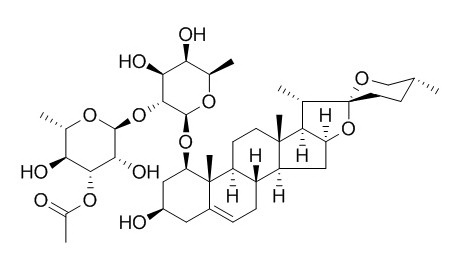Lirioprolioside B
Lirioprolioside B is a natural product from Liriope spicata (Thunb.) Lour.
Inquire / Order:
manager@chemfaces.com
Technical Inquiries:
service@chemfaces.com
Tel:
+86-27-84237783
Fax:
+86-27-84254680
Address:
1 Building, No. 83, CheCheng Rd., Wuhan Economic and Technological Development Zone, Wuhan, Hubei 430056, PRC
Providing storage is as stated on the product vial and the vial is kept tightly sealed, the product can be stored for up to
24 months(2-8C).
Wherever possible, you should prepare and use solutions on the same day. However, if you need to make up stock solutions in advance, we recommend that you store the solution as aliquots in tightly sealed vials at -20C. Generally, these will be useable for up to two weeks. Before use, and prior to opening the vial we recommend that you allow your product to equilibrate to room temperature for at least 1 hour.
Need more advice on solubility, usage and handling? Please email to: service@chemfaces.com
The packaging of the product may have turned upside down during transportation, resulting in the natural compounds adhering to the neck or cap of the vial. take the vial out of its packaging and gently shake to let the compounds fall to the bottom of the vial. for liquid products, centrifuge at 200-500 RPM to gather the liquid at the bottom of the vial. try to avoid loss or contamination during handling.
Sci Rep.2019, 9(1):4342
Braz J Med Biol Res. 2016, 49(7)
J Ethnopharmacol.2017, 198:91-97
Applied Biological Chemistry2023, 66:8
Bio-protocol2018, 9(14):e3301
Journal of Research in Pharmacy.2022, 26(6):p1752-1757.
J Tradit Chin Med.2023, 43(6):1081-1091.
Inflammation.2021, doi: 10.1007
Prev Nutr Food Sci.2024, 29(4):563-571.
Cell J.2024, 26(8):496-504.
Related and Featured Products
Phytochemistry. 1996 Sep;43(1):201-6.
Steroidal glycosides from the subterranean parts of Liriope spicata var. prolifera.[Pubmed:
8987515]
In a continuation of phytochemical studies on the underground organs of Liriope spicata var. prolifera, four new steroidal glycosides, lirioproliosides A-D, along with two known compounds, 25(S)-ruscogenin 1-O-[alpha-L-rhamnopyranosyl(1-->2)[beta-D-xylopyranosyl (1-->3)]-beta-D-fucopyranoside and ophiopogonin A, were identified.
METHODS AND RESULTS:
The structures of lirioproliosides A-D were established by a combination of spectroscopic and chemical methods as 25(S)-ruscogenin 1-O-[alpha-L-rhamnopyranosyl(1-->2)][beta-D-xylopyranosyl (1-->3)]-beta-D-fucopyranoside-3-O-alpha-L-rhamnopyranoside, 25(S)-ruscogenin 1-O-[3-O-acetyl-alpha-L-rhamnopyranosyl(1-->2)]-beta-D-fucopyranoside, 25(S)-ruscogenin (1-O-[2-O-acetyl-alpha-L-rhamnopyranosyl (1-->2)]-beta-D-fucopyranoside and ruscogenin (1-O-[2-O-acetyl-alpha-L-rhamnopyranosyl(1-->2)]-beta-D-fucopyranoside, respectively.
CONCLUSIONS:
Among these steroidal glycosides, ophiopogonin A and Lirioprolioside B, and lirioproliosides C and D, were isolated as epimeric pairs.
3-Hydroxy-4',5-dimethoxystilbene
Catalog No: CFN95199
CAS No: 58436-29-6
Price: $318/10mg
N-Methylcorydalmine
Catalog No: CFN95204
CAS No: 81010-29-9
Price: $398/5mg
Licoflavanone
Catalog No: CFN95213
CAS No: 119240-82-3
Price: $413/5mg
11-Deoxyisomogroside V
Catalog No: CFN95288
CAS No: 1628293-32-2
Price: $368/10mg
Violanone
Catalog No: CFN95385
CAS No: 52250-38-1
Price: $318/10mg
2,11,12-Trihydroxy-7,20-epoxy-8,11,13-abietatriene
Catalog No: CFN95428
CAS No: 1608462-12-9
Price: $318/10mg
12beta-Acetoxy-3beta-hydroxy-7,11,15,23-tetraoxo-lanost-8,20-diene-26-oic acid
Catalog No: CFN95468
CAS No: 1085338-75-5
Price: $318/5mg
Tembetarine
Catalog No: CFN95542
CAS No: 18446-73-6
Price: $318/5mg
Oxyphyllol B
Catalog No: CFN95575
CAS No: 226546-99-2
Price: Inquiry(manager@chemfaces.com)
Ephedrannin A
Catalog No: CFN95579
CAS No: 82001-39-6
Price: $318/5mg



